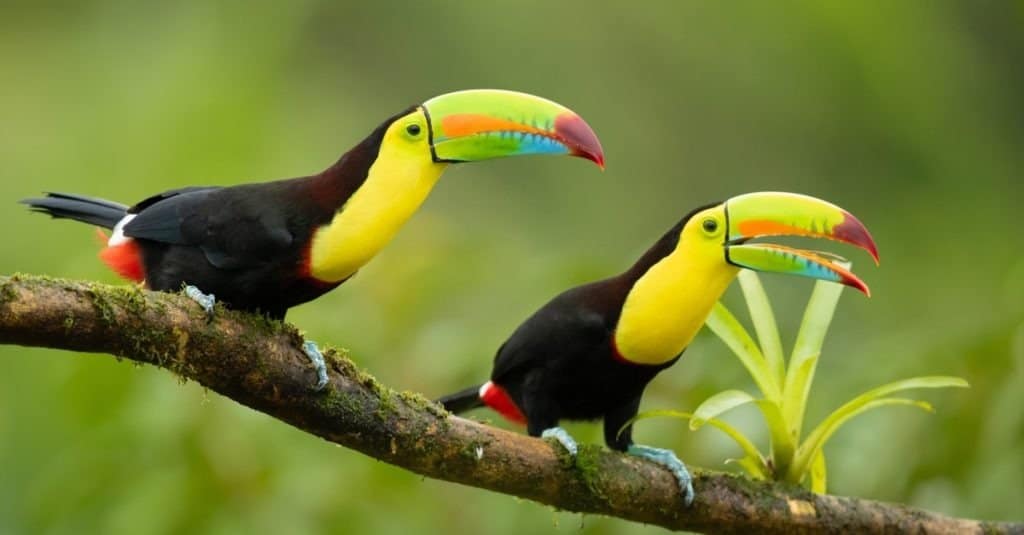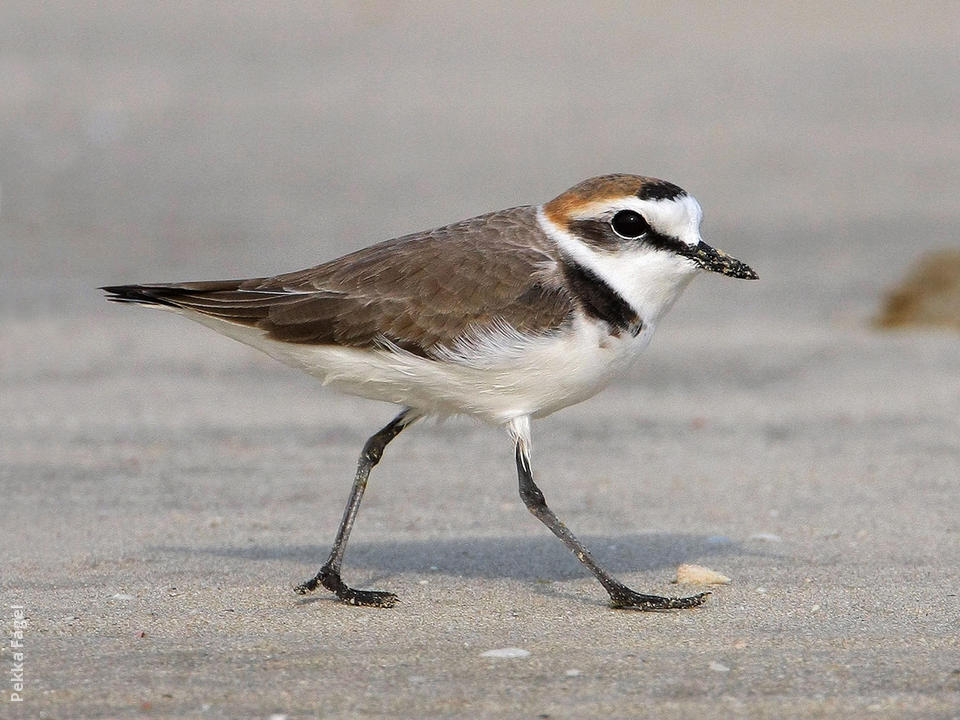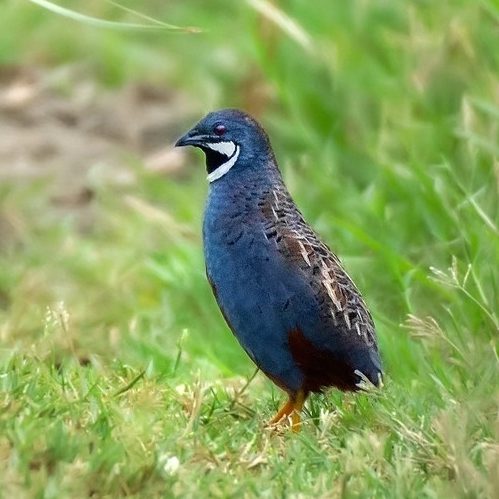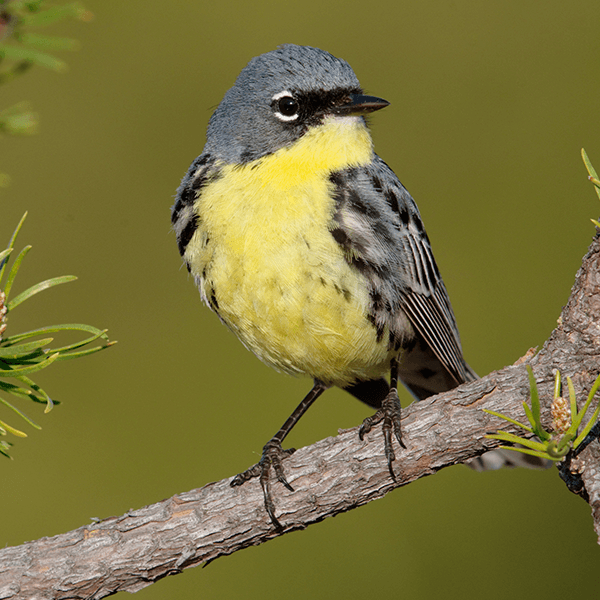Hey! I noticed that you like birds. Well, here is a list of birds that start with the letter K for you to enjoy. I’ve seen kids and adults alike get into a heated argument about what bird starts with K and somehow this list will do the magic to solve the argument.
King Vulture (Sarcoramphus papa)

Belonging to the Condor family of vultures, the King Vultures are a large scavenger species inhabiting Central and South America. These magnificent birds have been a part of American folklore and medicines for ages.
As their name might suggest, King Vultures rank among the largest vulture species globally. These birds have primarily white plumage, both on their upper and underparts.
Their secondary flight feathers and tail are black, while their almost bald face is partly black, with orange, red, and purple touches. The bill of these vultures is colored in red and has a sharp edge and a hooked tip.
Both sexes of the adults have identical plumage, but the females are the larger ones of the two. Although King Vultures are still on the Least Concern List, habitat loss is steadily taking a toll on their population.
Kelp Gull (Larus Dominicanus)
Kelp Gulls are a medium-sized gull species that are known by several names, including “Dominican Gull,” “Mollyhawk,” and “Black-backed Gull.”
Their natural range extends to South America, New Zealand, and Australia. These seabirds are not naturally found in North America; you will spot them in the United States only as a rare vagrant.
Kelp Gulls have a white head, upper parts, underparts, and underwings. Their wings are black-colored, with several white spots scattered on them. Their legs and bill are both yellow, with a red spot on their lower mandible.
The adult Kelp Gulls are sexually monochromatic and display dimorphism in size. The males are heavier than their female counterparts.
Kentucky Warbler (Geothlypis formosa)
Kentucky Warblers are a migratory warbler species belonging to the New World Warbler family. These little birdies can be found in moist deciduous forests and are not very common in urban and suburban areas.
Kentucky Warblers spend their breeding months in the central and eastern parts of the United States. During the winters, they migrate to the Caribbean islands.
The adult Kentucky Warblers are heavy-bodied with a significantly short tail. Their head and upper parts are olive green, with pale yellow undersides. A dark eye mask is prominent on their face, with darker touches on their crest.
The females are similarly colored as their male counterparts but have a slightly duller plumage.
Kentucky Warblers are primarily ground-dwelling birds that fly up to high branches while singing. They’re mainly insectivorous and feed on a variety of insects, such as grasshoppers, ants, aphids, grubs, and more.
King Penguin (Aptenodytes patagonicus)

Closely related to the Emperor Penguins but smaller in size, the King Penguins are the second-largest penguin species in the world.
These penguins breed on the coastal areas of the Subantarctic Islands. While foraging, they dive deep into the water bodies (up to 100 meters) to catch krill, squid, and lanternfish, which constitute their primary diet.
The adult King Penguins are sexually monochromatic, with the males being larger in size than their female counterparts. The sexes can also be distinguished based on their calling sounds.
Just like the other penguin species, King Penguins have a black face and upper parts, with white undersides. They also have yellow patches on their black bill, nape, and chest.
Keel-billed Toucan (Ramphastos sulfuratus)

Declared as the national bird of Belize, the Keel-billed Toucans are a Latin American toucan species that inhabit the tropical forests within their range. These birds have two recognized species.
Although Keel-billed Toucans appear large and bulky, they’re considerably lightweight due to their keratin-covered hollow bones. Their short-tailed body is covered entirely in black, except for their face and bill.
On their face, these birds have a lemon-yellow patch extending to their throat. Their bill is leafy-green, with an orange patch on the upper mandible and a red tip. The grey eyes of these toucans are surrounded with a touch of green, making them appear more highlighted.
The adult Keel-billed Toucans are sexually monomorphic, with both sexes appearing identical. They have an omnivore diet consisting of fruits, seeds, insects, lizards, small birds, and their eggs.
Kelp Goose (Chloephaga hybrida)
Belonging to the waterfowl family (Anatidae), the Kelp Geese are a shelduck species found in South America.
These birds have been named after their peculiar tendency of feeding on kelps excessively. In fact, you can even find them migrating in case of kelp scarcity on their breeding grounds.
The adult Kelp Geese are significantly sexually dimorphic. The males have a pure white plumage with dark eyes, bills, and yellow feet.
In contrast, their female counterparts are covered in dark brown plumage with heavy grey streaks. Their eye rings and legs are both yellow.
Female Kelp Geese have a strange egg-laying ritual. Once they’ve laid their eggs, it takes them about a month to hatch. During this period, mother geese will often hide their eggs in long grasses for protection.
Kea (Nestor notabilis)

Belonging to the New Zealand parrot family (Nestoridae), the Keas are endangered parrot species found in the alpine forests of New Zealand. Their population is on a steep decline, mainly due to illegal hunting and lead poisoning.
Keas are easily distinguishable from the parrots that you would commonly find as pets. They are exceptionally large in size and sport a dull plumage, like all the other Nestor parrots.
The plumage of these birds is colored mainly in olive green with touches of dark grey on their wings. Their eyes and cere are dark brown, with a hooked grey bill having an upper mandible considerably longer than the lower one.
While both sexes have identical plumage, they can be distinguished based on their overall size as well as bill size. The males are larger and have a longer upper mandible than their female counterparts.
Although the Keas are omnivores, they can feed on birds and mammals as large as rabbits and sheep.
Killdeer (Charadrius vociferus)

Killdeers are a partially migratory plover species endemic to the Americas. These wading birds are named after their calling sounds and have three subspecies.
Killdeers are quite large in comparison to other plover species and have a white face and underbody. They sport four black rings, two on their face and the other two on their throat. Their upper parts are pale rufous in shade, with dark brown wings.
The red-eye rings, short, dark bill, and orange legs and feet of Killdeers are some of their major field identification marks.
The best way to distinguish between the sexes is by their facial and chest bands. While these bands are black in males, in their female counterparts, they’re brown.
Knob-billed Duck (Sarkidiornis melanotos)

Also referred to as the “African Comb Duck,” the Knob-billed Ducks are globally among the large duck species.
These ducks primarily inhabit the tropical wetlands and have a widespread population in southern China, Madagascar, the Indian subcontinent, and sub-Saharan Africa.
Knob-billed Ducks closely resemble the American Comb Ducks and have a white head freckled with black spots. While their upper parts are glossy blue, the neck and undersides are pure white in color.
Both sexes of the adults have similar plumage but can be distinguished by their size and bill structure. Not only are the males larger than their female counterparts, but they also have the characteristic knob-like bill that is absent in the females.
King Eider (Somateria spectabilis)
King Eiders are a circumpolar sea duck species that breed in the Northern Hemisphere. They’re found in both tundra habitats and the Arctic coasts. During winters, you can easily spot them in the marine Arctic and Subarctic regions.
King Eiders display a significant sexual dimorphism, both in size and plumage. The males are much heavier than their female counterparts and appear different in the breeding seasons. However, the non-breeding males and females are quite similar to one another.
During the breeding season, the males have a mostly black body, both upper parts and under parts, except for their head and neck. They have a multi-colored head and white breast with a buff tinge on them. You can notice touches of pale blue on their head.
The females and non-breeding males appear similar and have an overall brown body with paler heads and necks.
Kentish Plover (Charadrius alexandrines)

Kentish Plovers are a small, cosmopolitan seabird species commonly found in lagoons, saline lakes, sand dunes, tundra, marshes, and deserts. These waders have a widespread distribution in the world, with some of their populations being partially migratory.
Kentish Plovers have a small body with black bills and dark legs. In plumage, both sexes display dimorphism. The males possess a dark head bar, ear coverts, breast band, and rufous nape. All these parts appear much paler in their female counterparts.
The visual differences between both sexes appear more defined in the breeding seasons when the males develop flank feathers much longer than their female counterparts.
King Quail (Synoicus chinensis)

Belonging to the same family as the peacocks, the King Quails are a heavy, ground-dwelling bird species distributed all across Australasia. They’re the smallest members of the quail family and have ten different subspecies.
King Quails are commonly used in the aviculture practice, where they’re popular as “Button Quail.”
These birds have small but plump bodies and occur in several colors, including blue, brown, maroon, silver, and black. Both sexes are similar in appearance, except the females don’t have a blue body.
King Rail (Rallus elegans)

Just as their name suggests, the King Rails are the largest rail species you can find in North America. These birds are a near-threatened species, with habitat loss being the main threat to their declining population.
Interestingly enough, King Rails are the only diurnal species, while all of their other relatives (rails) are primarily nocturnal.
These birds have a rusty brown face with darker bodies, while their throat and underbelly are pale buffs in color. Their bills are long with a slight curve, and so are their legs. Both sexes appear similar, showing little sexual dimorphism.
King Rails forage in shallow waters and feed primarily on crustaceans and other aquatic insects.
Kirtland’s Warbler (Setophaga kirtlandii)

Named in honor of the American naturalist Jared Potter Kirtland, the Kirtland’s Warblers are a near-threatened species of the New World Warbler family. They’re also referred to as the “Jack Pine Warbler.”
Kirtland’s Warblers are sexually dimorphic, with males having a bluish-grey head and upper parts covered with heavy black markings and a yellow belly. On the other hand, the females sport a duller plumage with paler markings all over.
Kenya Sparrow (Passer rufocinctus)
Just as their name suggests, the Kenya Sparrows are a medium-sized sparrow species found in Eastern Africa, particularly in Tanzania and Kenya. You can commonly spot these little birdies in the savannahs as well as the agricultural lands.
Kenya Sparrows have a grey head, with a rufous patch on each side of their face. Their upper body is brown with dark edges to their wings and tail, while the underparts are pale buff in color.
Knobbed Hornbill (Rhyticeros cassidix)

Knobbed Hornbills are a large hornbill species that are endemic to Indonesia. These birds are listed as Vulnerable Species by the IUCN.
Knobbed Hornbills have a primarily black body, a yellow bill, and white tail feathers. The adults display a significant sexual dimorphism in their faces.
The males have a rufous face with orange eyes and red casque atop their bill. On the other hand, the females have a black face, brownish eyes, and a yellow casque.
Due to their abundant population in the Sulawesi region, these birds are also called “Sulawesi Wrinkled Hornbill.”
Kimberley Honeyeater (Territornis fordiana)
The Kimberley Honeyeaters were initially considered a subspecies of the White-lined Honeyeaters but are now treated as an individual species. These birds are endemic to Western Australia and commonly inhabit paperback forests and rainforests.
Kimberley Honeyeaters have a black head cap and upper parts, while their underparts are stark white. They have a V-shaped black mark on their otherwise white chest. Both their legs and pointed bills are dark greyish in shade.
Key West Quail-dove (Geotrygon chrysia)
The Key West Quail-doves are primarily ground-dwelling bird species found in North America. These birds are closely related to the Bridled Quail-doves. Despite their name, they don’t breed in the Florida Keys and can only be seen in the region as a rare vagrant.
Key West Quail-doves have a rufous head and upper body with a grey stripe on the crown and two white stripes running through their cheeks. Their underparts are colored in a pale buff with a rosy tinge on them.
Kagu (Rhynochetos jubatus)
Also spelled “Cage,” the Kagus are a long-legged species belonging to the ground-dwelling bird family, Rhynchetidae. They’re an endangered species that have a severe threat due to their increased predation.
Kagus have a striking white plumage with touches of ash-grey on their wings. This is highly unusual for a ground-dwelling bird and could be a probable reason behind their easy predation.
Kagus are nearly flightless and display minimal dimorphism between the adult sexes.
Kashmir Flycatcher (Ficedula ficedula)

Kashmir Flycatchers are migratory passerine birds endemic to the Indian subcontinent. These birds breed in Kashmir and migrate to the Western Ghats and Sri Lanka during the winters.
Kashmir Flycatchers have a brownish-grey head and upper parts, with a pale rufous shade spreading on their chest. Their underparts are pale buff in color. Both sexes appear quite similar.
Karoo Chat (Emarginata schlegelii)
The Karoo Chats are small flycatcher species endemic to South Africa. They’re named after their preference for karoo as a habitat.
These birds are tiny and have greyish heads and upper parts, with black and white streaking. Their underparts are paler in comparison, with a straight bill and dark eyes.
Kakapo (Strigops habroptilus)

Also referred to as “Owl Parrot,” the Kakapos are a large parrot species native to New Zealand. They’re flightless and follow a strictly nocturnal routine and, thus, have “owl” in their name.
While Kakapos were once abundantly found in New Zealand, their population has now become critically endangered.
Kakapos have a large, rotund body colored in moss-green. Because they don’t fly, their flight feathers are considerably short. Their undersides are lighter than their back, with a touch of yellow.
Kerguelen Tern (Sterna virgata)
Endemic to the Kerguelen Islands, the Kerguelen Terns are a seabird species that inhabit the Southern Hemisphere. These terns are colonial and mainly feed on fish and insects.
They have a dark blue head with a lighter, grey underbody, wings, and tail. Their legs and bills are similarly colored in orange, and two white stripes run below their eyes.
Klaas’s Cuckoo (Chrysococcyx Klaas)

Endemic to sub-Saharan Africa, the Klaas’s Cuckoos are a cuckoo species that displays a prominent sexual dimorphism. The adult males have a glossy, dark green body with cottony-white underparts, while their female counterparts appear completely different.
They have a dull, bronze-colored body with a darker head and upperparts with pale brown undersides. In flight, males appear white and females brown.
Kruper’s Nuthatch (Sitta krueperi)
Named after the German naturalist Theodor Johannes Kruper, the Kruper’s Nuthatches are a small nuthatch species endemic to western Asia. These birds have a white face with a little black cap, a grey upper body, and a rufous band on their throat.
Conclusion: Birds That Start With K
Well, we’ve come to the end of our article on birds that start with the letter K! It was a long and winding road, but we’ve covered all bases. I would like to take this opportunity to thank our loyal readers. You’re all beautiful people.
Birds By Alphabet (A-Z List)
Birds that Start with A
Birds that Start with B
Birds that Start with C
Birds that Start with D
Birds that Start with E
Birds that Start with F
Birds that Start with G
Birds that Start with H
Birds that Start with I
Birds that Start with J
Birds that Start with K
Birds that Start with L
Birds that Start with M
Birds that Start with N
Birds that Start with O
Birds that Start with P
Birds that Start with Q
Birds that Start with R
Birds that Start with S
Birds that Start with T
Birds that Start with U
Birds that Start with V
Birds that Start with W
Birds that Start with X
Birds that Start with Y
Birds that Start with Z












